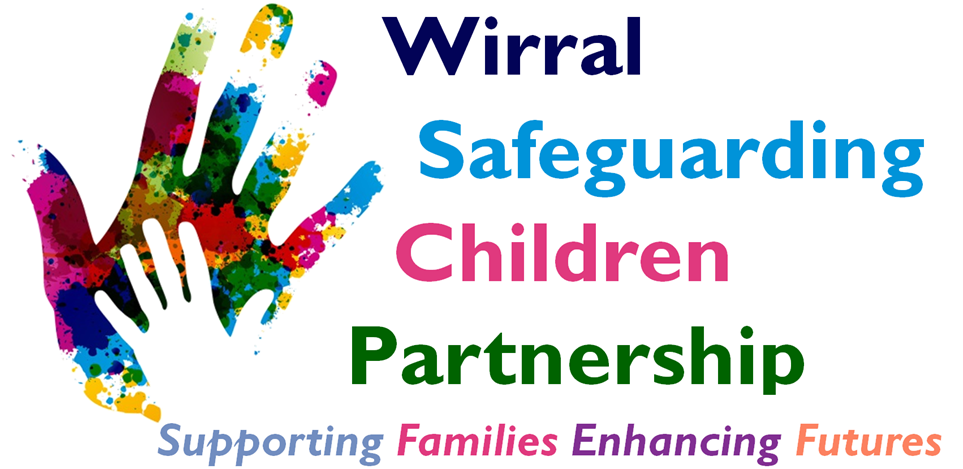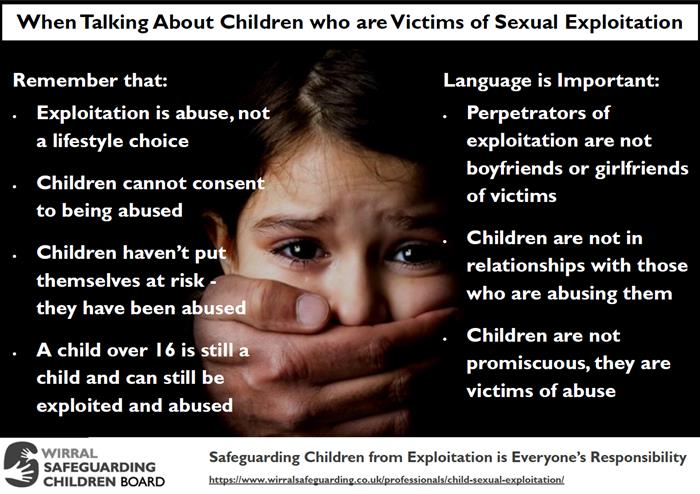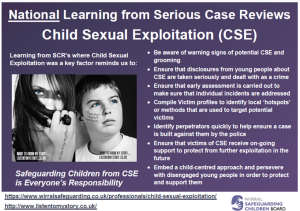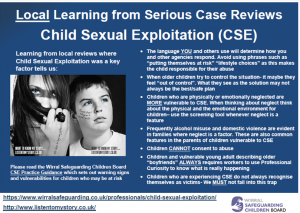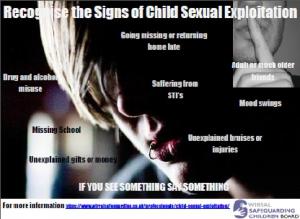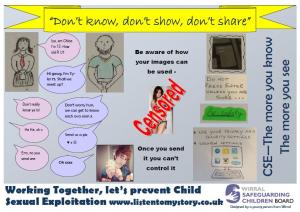Child Sexual Exploitation
On February 16th 2017 the government launched the revised definition of Child Sexual Exploitation along with new working together advice on CSE. The revised definition is detailed below:
Revised statutory definition of child sexual exploitation
Child sexual exploitation is a form of child sexual abuse. It occurs where an individual or group takes advantage of an imbalance of power to coerce, manipulate or deceive a child or young person under the age of 18 into sexual activity (a) in exchange for something the victim needs or wants, and/or (b) for the financial advantage or increased status of the perpetrator or facilitator. The victim may have been sexually exploited even if the sexual activity appears consensual. Child sexual exploitation does not always involve physical contact; it can also occur through the use of technology.
Also see information on: Child Abuse Child Criminal Exploitation Harmful Sexual Behaviour
Tackling child sexual exploitation is a top priority for the Wirral Safeguarding Children Board and the partnership.
A number of high profile cases have highlighted the need for vigilance from all of us, and not just those in statutory safeguarding services. We all need to be more aware of the signs of child sexual exploitation (CSE) and identify children and young people who are at risk.

The Merseyside safeguarding children boards in partnership with Merseyside Police have developed a website dedicated to raising awareness of child sexual exploitation. The http://www.listentomystory.co.uk website is a ‘one stop shop’ for information and advice about Child Sexual Exploitation whether you are a professional, child or young person, parent or carer, or a member of the public.
CSE Documents for Professionals
Forms
The cse-screening-tool-2017 is available for professionals to use prior to referral to identify the nature and level of CSE for individual young people. If the tool is completed and CSE is identified the form should accompany the completed Request for Services form into the Integrated Front Door ([email protected])
Withdrawal of CSE1 Referral Form. From September 2017 professionals are no longer required to complete a CSE1 Referral Form in cases of suspected or known child sexual exploitation. Professionals should use the screening tool and if CSE is indicated complete a Request for Services form (https://www.wirralsafeguarding.co.uk/public/concerned-about-a-child)and submit both into the Integrated Front Door.
The CSE Referral process is illustrated on the CSE Process Flowchart:
The CSE2 Risk Measurement Tool is a risk assessment form which will be used at the MASH, with young people and at the MACSE meetings to assess the risk faced by individual young people. Regular use of the tool will evidence whether the level of risk is decreasing over time. Completion of the tool is led by the social worker with input from the child, family and partner agencies. The form is generated from Liquid Logic for each case.
Protocols and Guidance
The CSE Protocol (Aug 17) sets out the multi-agency procedure for tackling child sexual exploitation in Wirral and across Merseyside. The protocol details how through the multi-agency child sexual exploitation (MACSE) meetings we can work together to reduce the harm to children and young people from CSE.
The CSE Practice Guidance (Aug 17) document contains guidance for professionals about CSE including signs and indicators, push and pull factors, trafficking, use of language and dangers of labelling etc. The Practice Guidance also includes case studies and details of the referral process.
The pan Merseyside CSE Strategy Jan V1 2016 sets out the approach across Merseyside to combat CSE through effective multi-agency and partnership working.
Language, Labelling and use of Inappropriate Terms
The way we use language influences our thinking. Recent Serious Case Reviews in other areas have highlighted this as a significant issue which contributed to systemic failure to protect.
There are some labels which in the past have been used to describe children and their behaviour which lead to inaccurate assumptions which in turn minimise the risks and reality of the child’s situation. Professional should avoid using such terms in their recording and conversations and should be mindful of when they enter their thinking and challenge them.
A short guide to inappropriate terms and suggested alternatives is provided below for professionals to use:
Language, labelling and inappropriate terms
An awareness raising poster about the importance of language and terminology is also available below:
Crimestoppers – and discontinuation of the PAiR system
Merseyside Police have a nationwide Crimestoppers telephone number which colleagues from partner agencies and members of the public can use to report intelligence. Crimestoppers is well established and replaces the PAiR (Partnership Automated Intelligence Reporting) system which has now been discontinued.
Merseyside Police have published a short video about the decommissioning of the PAiR system and the use of Crimestoppers. It is designed for all multi-agency professionals and can be viewed below or downloaded to be used in agencies.
The Crimestoppers number is 0800 555 111 (website: https://crimestoppers-uk.org/). Crimestoppers can be used to report intelligence which will support action to combat CSE, such as information about suspected perpetrators. However, it must not be used to report safeguarding concerns about individual children. These must be reported to the Integrated Front Door (0151 606 2008) in line with safeguarding procedures.
If at any time you believe a child is being harmed or at immediate risk of harm always dial 999.
Learning
As well as the practice guidance and the multi-agency training and e-learning the WSCB publishes CSE resources and learning on this website and the http://www.listentomystory.co.uk website too. Presented below are two posters which provide messages for practitioners based on learning from national Serious Case Reviews and local reviews. The WSCB recommends that partner agencies display the posters and use them as discussion items in supervision sessions and team meetings.
CSE Learning from national Serious Case Reviews:
WSCB National Learning from SCR’s – CSE
CSE Learning from local reviews:
WSCB Local Learning from SCR’s – CSE
CSE Resources
Childline app ‘For Me’, built in partnership with Barclays. It’s the first app to provide counselling to young people in need of help, directly through their smartphone. Teenagers behind the development of the service appeared with Dame Esther Rantzen on Good Morning Britain and Sky News, as well as featuring on the BBC School Report.
The head of helplines John Cameron said: “Launching the ‘For Me’ app shows how we’re continuing to capitalise on new technology to give children and young people the easiest possible access to Childline’s free and confidential advice and support. Its development will enable our younger generation to tap directly into Childline’s expanding range of services through their mobile phone whenever and wherever they need our help.”
Safe Skills from the Ariel Trust
‘SafeSkills’ is a new preventative education resource for young people aged 9-12 years. The resource aims to improve the safety of young people in our community in relation to the risks associated with ‘grooming’.
The resource has been developed in partnership with various agencies, such as NSPCC and Liverpool’s ‘Protect’ team. We have consulted teachers to ensure the resource is age appropriate and that the lessons support both teacher and pupil needs.
The resource consists of three modules; ‘motivations and intentions’, ‘talking about your feelings’ and ‘the role of the bystander’. It includes short films and interactive activities designed to promote discussion in a safe space.
Using films and interactive, skill based, activities about ‘grooming’ behaviour and controlling relationships, the resource will develop young people’s resilience, equipping them with the necessary skills to protect themselves against grooming risks.
The film themes consist of; ‘gaming’, ‘gifts’, ‘park life’, ‘disclosing personal information online’, ‘communicating feelings’ and ‘the role of the bystander’.
‘SafeSkills’ will be used by teachers and other professionals to empower young people in practical ways. The resource focuses on identifying opportunities for a young person to take positive action or to ask for support.
‘SafeSkills’ will help young people to develop their communication skills and increase their resilience, helping them to build a network of people that they can turn to for support. The resource presents realistic situations in an implicit, non-threatening but thought provoking way.
Claire McKinnon, Year 6 teacher from St. William of York said, “Our kids loved the resource and it was really relevant to their needs.”
If you would like more information – or access to safe skills, please contact [email protected].
Click here for the safeskills website.
Kayleigh’s Love Story
This video was developed by Leicestershire Police following the true case of a 15 year old girl who was groomed online by a man she didn’t know over the course of just 13 days and then was tragically murdered by his friend. The video is currently being used with schools in Leicestershire to raise awareness of the importance of online safety.
Kayleigh Haywood began speaking to Luke Harlow, a man she had never met, on 31 October 2015.
Over the course of 13 days they exchanged 2643 messages. Harlow told the 15-year-old all the things many teenage girls want to hear. He told her she was beautiful, how much he cared for her and that she was special.
Harlow was grooming Kayleigh, along with two other young girls he had also been speaking to. But it was Kayleigh that finally agreed to his requests to spend the night of Friday 13 November 2015 at his house.
She spent the next day with him too, and in the early hours of Sunday 15 November, having been held against her will by Harlow and by his next door neighbour Stephen Beadman, Kayleigh was raped and murdered by Beadman.
Kayleigh’s Love Story is as a warning to young people, both girls and boys, about the dangers of speaking to people they don’t know online. The film highlights just how quick and easy it can be for children to be groomed online without them or those around them knowing it is happening. Its purpose is to protect children now and in the future and to stop another family losing a child in this way.
Facts about the film
The film lasts around five and a half minutes and is available to view now. The film was made by Affixxius Films in Loughborough and was shot in various locations across Leicestershire and in Nottingham. The film and the trailer both contain warnings. If either were to be screened at a cinema, they would carry a 15 certificate.
Further information and resources about CSE can be found on this website and information specifically for young can be found on the Merseyside Listen to my Story website: http://www.listentomystory.co.uk/
Alright Charlie
This resource was developed by the Yorkshire MESMAC as part of the nationally recognised BLAST project. Yorkshire MESMAC is one of the oldest and largest sexual health organisations in the country and offers a variety of services, training and resources.
The Alright Charlie learning resource is designed for use with children aged 9-11 in primary schools and aims to highlight the warning signs of grooming in an age appropriate way. The film is seen through the eyes if Charlie who is groomed by Danny. The resource was designed in consultation with CSE professionals, primary schools teachers and children in years 5 and 6 in primary schools. The resource is accessible to girls AND boys with the viewer never discovering Charlie’s gender.
The resource includes a guidance book for professionals and a workbook for children and young people
There is also a video resource which can be accessed below:
https://www.youtube.com/watch?v=UGEgn767XAk
Catch22
As the Missing From Home/Child Sexual Exploitation Commissioned Service in your Local Authority, Catch22 have undertaken a piece of work with both local children and local professionals to identify the attached pieces of advice for children and professionals around preventing CSE online, and issue identified by local young people as a large concern for them.
Catch22 also have a film that has been made using real stories from that work that we undertake. You can find that video here: https://youtu.be/Z293D3_OPbs
A Key area for development around Child Sexual Exploitation in 2017 has been the change in the national definition of CSE and Working Together Guidance which went live on the 16th February. Information regarding the changes can be found here: https://www.nwgnetwork.org/child-sexual-abuse-csa-definition/
If you have any concerns, would like advice or guidance around any concerns you may have or would like some ideas around activities you can undertake to raise awareness of CSE with your staff teams, parents or children, please feel free to get in contact with your Catch22 CSE Team on: [email protected] 0151 666 4897 or 07979 241502
Leaflets from Catch22:
Catch22-CSE-leaflet-parents-carers
Catch22-Missing-From-Home-young-people
Barnardos
Barnardos publish a number of resources for children and young people, professionals and parents and carers about Child Sexual Exploitation including their Spot the Signs guidance. Their leaflets can be accessed here:
Spot the Signs leaflet for Children and Young People
Spot the Signs leaflet for Parents and Carers
Spot the Signs leaflet for Professionals
Further information from Barnardo’s is available from their website: https://www.barnardos.org.uk/what_we_do/our_work/cse-home
PACE
Pace (Parents Against Child Sexual Exploitation) work alongside parents and carers of children who are – or are at risk of being – sexually exploited by perpetrators external to the family. They offer guidance and training to professionals on how child sexual exploitation affects the whole family, and resources, guidance and advise to parents and carers which can be accessed from their website: http://paceuk.info/
Lead Officers for Child Sexual Exploitation
The safeguarding board has published guidance for agencies on the role of Lead Officer for CSE. This is the person(s) in the organisation, usually the safeguarding lead who colleagues can go to for advice about using the CSE tools, making a referral and how the process works. The guidance document can be accessed below:
cse-lead-officer-role-and-information
Local Lead Officers :
| Organisation | Name | Email address |
| Adolescent Support Team / Response | Colette Simmons | [email protected] |
| Brook Wirral | Jules Jones | [email protected] |
| Catch 22 | Vikki McKenna | [email protected] |
| Cheshire & Wirral Partnership NHS Foundation Trust | Jill Cooper | [email protected] |
| Education Social Welfare Service | Mike Clarke | [email protected] |
| Family Intervention Service | Sheena Herbert | [email protected] |
| Forum Housing | Sue Barker | [email protected] |
| Targeted Services | Lindsay Davidson | [email protected] |
| The Vocational College | Laura Lane | [email protected] |
| The Vocational College | Jess Raybould | [email protected] |
| Wirral Community NHS Trust | Joanne Chwalko | [email protected] |
| Wirral University Teaching Hospitals NHS Trust (Arrowe Park) | Sue Fogarty | [email protected] |
| Youth Offending Service | Ed Rowland | [email protected] |
| Youth Support Service | Steve Chan | [email protected] |
Social media
Available below is a guide to many of the common social media chat, instant messaging and picture sharing apps widely used by children and young people.
An updated list of 183 gaming and social media apps commonly used by young people is available here: Social Media Library April 2018. The list includes the names and description of the apps.
The WSCB has produced three CSE awareness raising posters which can be downloaded here:
CSE Training for Professionals
The WSCB offers a full day multi-agency training session about Child Sexual Exploitation. This course is available free of charge to all children’s services professionals. Details of the course, dates and how to book can be found by clicking here.
Latest CSE Publications and Reports
As CSE and Exploitation related reports and research are published we will add them to the website below:
Joint Targeted Area Inspections (JTAI)
The report of the 5 JTAI’s published in September 2016 on the topic of CSE and Missing Children called A Time to Listen can be downloaded here:
Time to listen a joined up response to Child Sexual Exploitation and Missing Children
In 2018 a further set of JTAI’s have been undertaken about CSE, Gangs, criminal exploitation and missing. The area reports can be accessed below:
Southend-On-Sea Joint Targeted Area Inspection Report
Greenwich Joint Targeted Area Inspection Report
Sexual Communication with a child
On the 3rd April 2017 S.67 of the Serious Crime Act 2015 came into force.
S.15A provides: Sexual communication with a child
(1)A person aged 18 or over (A) commits an offence if
(a)for the purpose of obtaining sexual gratification, A intentionally communicates with another person (B),
(b)the communication is sexual or is intended to encourage B to make (whether to A or to another) a communication that is sexual, and
(c)B is under 16 and A does not reasonably believe that B is 16 or over.
(2)For the purposes of this section, a communication is sexual if
(a)any part of it relates to sexual activity, or
(b)a reasonable person would, in all the circumstances but regardless of any person’s purpose, consider any part of the communication to be sexual;
and in paragraph (a) sexual activity means an activity that a reasonable person would, in all the circumstances but regardless of any person’s purpose, consider to be sexual.
(3)A person guilty of an offence under this section is liable
(a)on summary conviction, to imprisonment for a term not exceeding 12 months or a fine or both;
(b)on conviction on indictment, to imprisonment for a term not exceeding 2 years
The notes to the Act state:
The offence criminalises conduct where an adult intentionally communicates (for example, by e-mail, text message, written note or orally) with a child under 16 (whom the adult does not reasonably believe to be aged 16 or over) for the purpose of obtaining sexual gratification if the communication is sexual or intended to encourage the child to make a communication that is sexual (new section 15A(1) and (2)). Scenarios likely to be covered by the offence include talking sexually to a child via a chatroom or sending sexually explicit text messages to a child as well as inviting a child to communicate sexually (irrespective of whether the invitation is itself sexual). The new offence is designed to ensure that it does not criminalise, for example, ordinary social or educational interactions between children and adults or communications between young people themselves. The term sexual gratification is already used in the context of the offences at sections 11 and 12 of the Sexual Offences Act 2003 which prohibit engaging in sexual activity in the presence of a child and causing a child to watch a sexual act respectively. It is clear from case law in relation to the section 12 offence that this wording would support a successful prosecution where either a defendant made a relevant communication in order to obtain immediate sexual gratification or the obtaining of such gratification was part of a longer term plan or both. The case law also confirms that the term has a wide meaning, stating that the sexual gratification which is alleged may take any of the myriad forms which sexual pleasure or indulgence may take. It is expected that the courts will interpret the reference to sexual gratification in the sexual communication with a child offence in the same way.
Boys Don’t Cry – A report by the Children’s Society into the sexual exploitation of young men trafficked into the UK, March 2016
Boys and Trafficking Report March 2016
Serious Case Review report from Bristol LSCB following an investigation into the organised exploitation of children (Operation Brooke).
Serious Case Review Report – Organised CSE Operation Brooke
Below is a report published by the National Working group for CSE which highlights the similarities between some forms of Child Sexual Exploitation and the Trafficking of Human Beings, and the advantages of the legislation when taken in the partnership as a response to a child safeguarding strategy and criminal investigation.
Understanding Modern Slavery Act
Seen and Heard Campaign
In July 2016 the Department for Health and the Children’s Society launched the Seen and Heard campaign to raise awareness of the signs of sexual abuse and exploitation. More information can be found HERE or visit the campaign’s website:
http://www.seenandheard.org.uk
If you believe a child is at risk
If a child or young person is at risk of harm, abuse or neglect please report it to the Wirral Central Advice and Duty Team (0151 606 2008) 9.00am-5.00pm Monday to Friday.
Outside of these hours please call 0151 677 6557. In an emergency always dial 999.
E-mail: [email protected]
In an emergency always call the police on 999.
